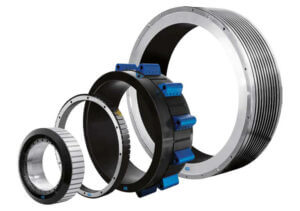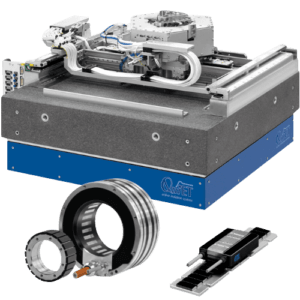May 13, 2020
How to choose the right torque motor
Many factors need to be considered when choosing a torque motor to ensure outstanding system performance. Here is a basic overview of some of the key selection factors that should be taken into account when choosing a torque motor.
If you’re still curious about why direct-drive motors are so effective, you can read a detailed technical explanation here.
 1. Motor sizing
1. Motor sizing
The first step in a torque motor sizing is to define the torque and speed requirements for the application. The torque required for each move within the cycle can then be used to determine the continuous torque. When calculating the continuous torque it is important to consider all factors such as friction, machining torque, static force due to an offset load, and external perturbations.
Power dissipation of the motor is estimated calculating the continuous torque. The amount of heat produced by motor power dissipation will determine the temperature increase of the structure and if liquid cooling is required.
Under static conditions with an applied load, one motor phase can get disproportionately hot, because the power dissipation is not shared equally among all three phases. To ensure safe operation under these conditions a stall torque calculation should be performed.
2. Detent effects
Thanks to our technology know-how, HEIDENHAIN has the expertise to manufacture ironcore torque motors with very low detent effects. Our design uses an innovative combination of open slots, orthocyclic windings and fractional pole pitch. This solution significantly reduces detent effects without any skewing of laminations or magnets which would result in lower torque density
3. Motor constant
The motor constant, Km, is one of the key parameters for comparing permanent magnet synchronous motors. It shows the relationship between torque produced and resulting power losses. A motor with a higher value of Km is a more efficient generator of torque. Km is determined by the design and construction of the motor. This parameter is related to the internal design of the motor (copper filling factor, electromagnetic design, etc). Therefore, it is a better indicator of motor performance than the torque constant, Kt (Nm/Arms), which relates torque output to the supplied current. In some motors, Kt can be easily adjusted by changing the winding type. Kt is useful for matching a motor to a servo amplifier, but it does not provide information about the motor’s efficiency.
 4. Thermal considerations
4. Thermal considerations
Like all servo motors, torque motors generate heat in operation. In order to reduce thermal expansion of the machine, this heat has to be removed as efficiently as possible. ETEL TMBs and TMKs torque motors, for example, provide optimized cooling channel design to ensure a maximum heat evacuation through the coolant. Keeping the machine structure cool is mandatory to reach high precision and repeatability levels.
Torque motors can be cooled either by free air convection or with a liquid coolant. Liquid cooling is recommended for demanding applications where coolant is available. Due to their optimized electromagnetic design, HEIDENHAIN and ETEL’s torque motors produce much more torque for the same input power than competitive products.
On any direct drive application, the thermal management is of major importance and closely related to the final machine performance. In fact, in a direct drive axis, the motor is located very close to the working point. This is a big advantage in terms of mechanical stiffness and leads to unmatched machine performance. However, the fact that the motor is highly integrated also means that the heat generation is closer to the critical area than in a conventional worm gear system for example.
The HEIDENHAIN Family of Brands has extensive experience in torque motor integration, including heat management. HEIDENHAIN has been exclusively dedicated to the development of direct drive technology. Through numerous innovations and patented designs, HEIDENHAIN continues to provide unmatched torque efficiency for the most optimized performance.

